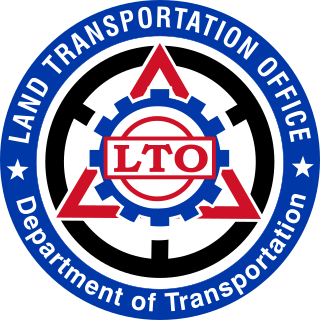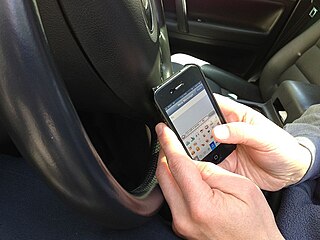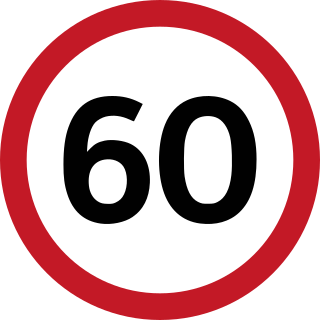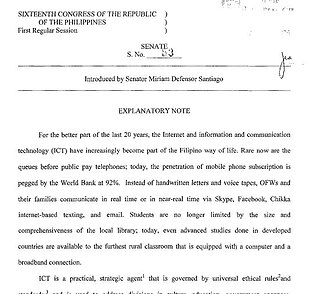
Driving under the influence (DUI) is the offense of driving, operating, or being in control of a vehicle while impaired by alcohol or drugs, to a level that renders the driver incapable of operating a motor vehicle safely. Multiple other terms are used for the offense in various jurisdictions.

Mobile phone use while driving is common but it is dangerous due to its potential for causing distracted driving and subsequent crashes. Due to the number of crashes that are related to conducting calls on a phone and texting while driving, some jurisdictions have made the use of calling on a phone while driving illegal in an attempt to curb the practice, with varying levels of efficacy. Many jurisdictions have enacted laws making handheld mobile phone use illegal. Many jurisdictions allow use of a hands-free device. Driving while using a hands-free device has been found by some studies to provide little to no benefit versus holding the device itself and carrying on a conversation. In some cases restrictions are directed only at minors, those who are newly qualified license holders, or to drivers in school zones. In addition to voice calling, activities such as texting while driving, web browsing, playing video games, or phone use in general may also increase the risk of a crash.
For driving in the United States, each state and territory has its own traffic code or rules of the road, although most of the rules of the road are similar for the purpose of uniformity, given that all states grant reciprocal driving privileges to each other's licensed drivers. There is also a "Uniform Vehicle Code" which was proposed by a private, non-profit group, based upon input by its members. The UVC was not adopted in its entirety by any state. As with uniform acts in general, some states adopted selected sections as written or with modifications, while others created their own sui generis statutes touching upon the same subject matter. As required by the federal Highway Safety Act of 1966, all states and territories have adopted substantially similar standards for the vast majority of signs, signals, and road surface markings, based upon the Manual on Uniform Traffic Control Devices from the U.S. Department of Transportation. Many of the standard rules of the road involve consistent interpretation of the standard signs, signals, and markings such as what to do when approaching a stop sign, or the driving requirements imposed by a double yellow line on the street or highway. In order to implement their own traffic laws on the property of their own facilities, several federal agencies have also developed their own traffic laws.
Many countries have adopted a penalty point or demerit point system under which a person’s driving license is revoked or suspended based on the number of points they’ve accumulated over a specific period of time, points are given for traffic offenses or infringements committed by them in that period. The demerit points schemes of each jurisdiction varies. These demerit schemes are usually in addition to fines or other penalties which may be imposed for a particular offence or infringement, or after a prescribed number of points have been accumulated.

The Land Transportation Franchising and Regulatory Board is an agency of the Republic of the Philippines under the Department of Transportation (DOTr). The LTFRB was established on June 19, 1987, during the former president Corazon Aquino’s administration.

The Land Transportation Office is an agency of the Philippine government under the Department of Transportation responsible for all land transportation in the Philippines. Functions of the LTO include the inspection and registration of motor vehicles, issuance of licenses and permits, enforcement of land transportation rules and regulations, and adjudication of traffic cases.

The Human Security Act of 2007, officially designated as Republic Act No. 9372, was a Philippine law that took effect on July 20, 2007. The law, which was watered-down after opposition from some politicians and rights groups feared the legislation would endanger human rights, was aimed at tackling militants, particularly the Abu Sayyaf, in the southern Philippines.

A move over law is a law which requires motorists to move over and change lanes to give safe clearance to law enforcement officers, firefighters, ambulances, utility workers, and in some cases, tow-truck drivers and disabled vehicles. In the past, Canada and United States have used this term to apply to two different concepts; however, this is beginning to change as Canadian provinces have begun expanding the scope of their move over laws.

Sherwin Ting Gatchalian, known as Win Gatchalian, is a Filipino politician and businessman serving as a Senator since 2016. A member of the Nationalist People's Coalition (NPC), he previously served as the Representative of Valenzuela's 1st district from 2001 to 2004 and from 2013 to 2016. He was the Mayor of Valenzuela from 2004 to 2013.

Texting while driving, also called texting and driving, is the act of composing, sending, or reading text messages on a mobile phone while operating a motor vehicle. Texting while driving is considered extremely dangerous by many people, including authorities, and in some places has either been outlawed or restricted. As a form of distracted driving, texting while driving significantly increases the chances that a driver will be involved in a motor vehicle accident.

Speed limits in the Philippines are specified in Republic Act No. 4136, or the Land Transportation and Traffic Code of the Philippines, which took effect on its approval on June 20, 1964. The act covers a number of areas other areas than speed limits, and was amended regarding some of those areas by Republic Act No. 10930, which was approved on August 2, 2017.

Distracted driving is the act of driving while engaging in other activities which distract the driver's attention away from the road. Distractions are shown to compromise the safety of the driver, passengers, pedestrians, and people in other vehicles.

Various laws in the United States regulate the use of mobile phones and other electronics by motorists. Different states take different approaches. Some laws affect only novice drivers or commercial drivers, while some laws affect all drivers. Some laws target handheld devices only, while other laws affect both handheld and handsfree devices.

People who are driving as part of their work duties are an important road user category. First, workers themselves are at risk of road traffic injury. Contributing factors include fatigue and long work hours, delivery pressures, distractions from mobile phones and other devices, lack of training to operate the assigned vehicle, vehicle defects, use of prescription and non-prescription medications, medical conditions, and poor journey planning. Death, disability, or injury of a family wage earner due to road traffic injury, in addition to causing emotional pain and suffering, creates economic hardship for the injured worker and family members that may persist well beyond the event itself.

The Magna Carta for Philippine Internet Freedom is an internet law bill filed in the Congress of the Philippines. The bill contains provisions promoting civil and political rights and Constitutional guarantees for Philippine internet users, such as freedom of expression, as well as provisions on information and communications technology (ICT) policy, ICT4D, internet governance, e-governance, cybersecurity, cyberwarfare, cyberterrorism, and cybercrime.
A textalyzer is a proposed device that would allow the police to detect illegal text messaging while driving. The device has been promoted as a means of reducing distracted driving. The device would be used by police officers who suspect that a driver has been texting while driving using similar procedures currently in place for drivers suspected of driving under the influence. The device would be connected to the driver's mobile phone and would scan the phone for calls, e-mails, or text messages sent when the driver would have been operating the vehicle.

Proclamation No. 55 was signed by Philippine President Rodrigo Duterte on September 4, 2016, to officially declare a state of emergency in the Philippines in response to the 2016 Davao City bombing.

The No Contact Apprehension Policy (NCAP) refers to different active traffic management and road traffic safety measures being implemented by local government units all over the Philippines.

On the late afternoon of August 8, 2023, a road rage incident occurred when former Philippine National Police (PNP) officer Wilfredo Gonzales, driving a red Kia Rio, cut off Allan Bandiola, who was riding his bicycle in the bicycle lane near Welcome Rotonda in Doña Josefa, Quezon City, the Philippines. Following the altercation, Gonzales exited his car, threatened to shoot the cyclist with a handgun, and slapped him on the head. On the same day, a settlement was reached between both parties, with Bandiola paying ₱500 to Gonzales for damages to his car.

Traffic law in the Philippines consists of multiple laws that govern the regulation and management of road transportation and the conduct of road users within the country.
















